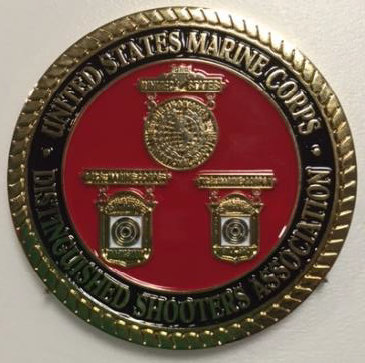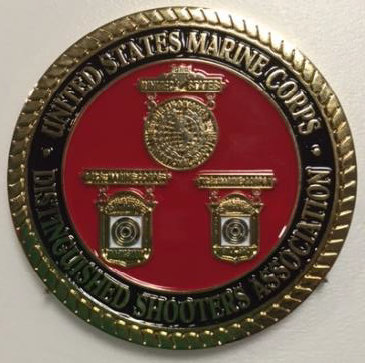Impact of Distinguished Marines on the Corps’ Mission down through history
We welcome from our Members the nomination of Distinguished Marines to be considered for inclusion in this list. …This will be a listing of those Distinguished Marines who contributed significantly to the successful accomplishment of the Corps’ Mission down through history, both during war and in peace. This would of course include those who markedly contributed to the achievement and advancement of Marksmanship Excellence throughout the ranks of the United States Marine Corps.
Please submit any nominations via the “Contact Us” form, or, via mail. …thank you, and, Semper Fi!

BRIGADIER GENERAL
WILLIAM H. RUPERTUS, USMC (DECEASED)
Distinguished Marksman Badge awarded in 1915
and,
The History of the Marine’s Rifle Creed:
In a conversation which took place sometime early in 1942 between BGen William H. Rupertus, USMC, Commanding General, Marine Corps Base, San Diego, and Capt Robert P. White, USMCR, Public Relations Officer of the base, the general stated that his men must be made to understand “that the only weapon which stands between them and Death is the rifle…they must understand that their rifle is their life…it must become a creed with them.” Whereupon Capt White suggested that the general write an editorial to that effect with the tentative title of “My Rifle is My Life.” The general, who had won the Distinguished Marksmanship Badge as a second lieutenant in 1915, liked the title but disagreed with the idea of an editorial which he considered would sound like a sermon. Instead, he felt that the rifle creed should be “something so deep, a conviction so great, a faith so lasting that no one should have to be preached to about it.”
The very next morning, the general appeared in the captain’s office with a “random scrap of paper” on which were penciled the notes which have since become the rifle creed. Capt White’s part in the final production of the creed is best expressed in his own words: “All I did was to translate it, type it, suggest a few different word usages and add a line here and there to complete the General’s thought. My job was that of an editor; and no editor could have bettered the General’s piece in that particular.”
Reference Branch
Marine Corps History Division
MARINE’S RIFLE CREED
My Rifle – The Creed of a United States Marine
This creed, accredited to Major General William H. Rupertus, USMC (Deceased) and still taught to Marines undergoing Basic Training at the Recruit Depots at San Diego and Parris Island, was first published in the San Diego Marine Corps Chevron March 14, 1942.
1. This is my rifle. There are many like it, but this one is mine.
2. My rifle is my best friend. It is my life. I must master it as I must master my life.
3. My rifle, without me, is useless. Without my rifle, I am useless. I must fire my rifle true. I must shoot straighter than my enemy who is trying to kill me. I must shoot him before he shoots me. I will …
4. My rifle and myself know that what counts in this war is not the rounds we fire, the noise of our burst, nor the smoke we make. We know that it is the hits that count. We will hit….
5. My rifle is human, even as I, because it is my life. Thus, I will learn it as a brother. I will learn its weaknesses, its strength, its parts, its accessories, its sights and its barrel. I will ever guard it against the ravages of weather and damage as I will ever guard my legs, my arms, my eyes and my heart against damage. I will keep my rifle clean and ready. We will become part of each other. We will ….
6. Before God, I swear this creed. My rifle and myself are the defenders of my country. We are the masters of our enemy. We are the saviors of my life.
7. So be it, until victory is America’s and there is no enemy, but peace!!
Citation:

GUNNERY SERGEANT
CARLOS NORMAN HATHCOCK II, USMC (DECEASED)
Distinguished Marksman Badge awarded in 1965
“Before deploying to South Vietnam, Hathcock had won shooting championships, including matches at Camp Perry and the Wimbledon Cup. In 1966, Hathcock started his deployment in the Vietnam War as a military policeman and later became a sniper after Captain Edward James Land pushed the Marines into raising snipers in every platoon. Land later recruited Marines who had set their own records in sharpshooting; he quickly found Hathcock, who had won the Wimbledon Cup, the most prestigious prize for long-range shooting, at Camp Perry in 1965.
During the Vietnam War, Hathcock had 93 confirmed kills of PAVN* and Viet Cong personnel. In the Vietnam War, kills had to be confirmed by a third party, who had to be an officer, beside the sniper’s spotter. Snipers often did not have a third party present, making confirmation difficult, especially if the target was behind enemy lines, as was usually the case. Hathcock himself estimated that he had killed between 300 and 400 enemy personnel during the Vietnam War.”
*aka NVA
GySgt. Carlos Hathcock’s awards included the Silver Star, the Purple Heart, and, the Navy Commendation Medal.
Citation:
https://en.wikipedia.org/wiki/Carlos_Hathcock

COLONEL
HENRY PIERSON CROWE, USMC (DECEASED)
Distinguished Marksman Badge awarded in 1927
Henry “Jim” Pierson Crowe was born on 7 March 1899, in Boston, Kentucky. After attending high school at Mt. Pulaski, Illinois, he enlisted in the Marine Corps on 28 October 1918. As an enlisted man he served in the Dominican Republic from 1921 to 1923, in Nicaragua in 1928 and at various other posts and stations. He was also a frequent participant in local and national shooting competitions, winning the coveted Distinguished Marksman Medal in 1927.
Commissioned a Marine Gunner (a warrant officer rank) in September 1934, he served on Pacific maneuvers and at several stations in the United States during the next two years. He embarked for China in October 1936, and after three years with the Marine Detachment at the American Embassy, Peiping, he returned to the U.S. in October 1939, to join the 6th Marine Regiment at San Diego, California. He was transferred to the 8th Marine Regiment in April 1949, and was promoted to Chief Marine Gunner in February 1941.
Chief Marine Gunner Crowe embarked with the 8th Marines for Samoa in January 1942, and the following month was promoted from chief gunner to captain. He was promoted to major in March 1943 and to lieutenant colonel in January 1944. He served as commander of the regimental weapons company of the 8th Marines at Guadalcanal, where he was awarded both a Silver and Bronze Star Medal and commanded 2d Battalion, 8th Marines, at Tarawa and Saipan. He was awarded the Navy Cross and British Distinguished Service Cross at Tarawa, and the Purple Heart with Gold Star in lieu of a second award for wounds received at Saipan.
Lieutenant Colonel Crowe served with the 8th Marines in New Zealand and Hawaii before he returned to the United States in September 1944, for treatment of the wounds he received at Saipan. He was released from the U.S. Naval Hospital at San Diego in March 1945, and the following month was named Training Officer of Fleet Marine Force, Pacific, at Pearl Harbor, Territory of Hawaii.
After the war’s end, LtCol Crowe served briefly with the 29th Marines in China, and with Marine Garrison Forces, 14th Naval District, at Pearl Harbor. He returned to the United States in March 1946, and after duty at San Diego and Quantico, Virginia, entered the Senior Course in the Amphibious Warfare School at Quantico in September 1947. He completed the course in May 1948, and reported to the 1st Marine Division at Camp Pendleton, California, the following month. There, he served as a battalion executive officer, as division special service officer, and as executive officer of the 1st Shore Party Battalion before taking command of the unit in July 1950.
He arrived in Japan in August 1950 to assist in preparations for the Inchon landing in Korea. He remained with the 1st Shore Party Battalion, 1st Marine Division from September 1950 to May 1951 and was awarded the Legion of Merit with Combat “V” for outstanding service during the Inchon-Seoul Campaign and Wonsan landing. He returned to the United States in May 1951.
Lieutenant Colonel Crowe was promoted to colonel in December 1951, while serving as Chief of the Tactical School Section, Troop Training Unit, Amphibious Training Command, at Coronado, California. He later served there as Chief of the Administrative Schools Section before assuming command of the Headquarters and Service Battalion at the Recruit Depot, San Diego, in January 1953. He was assigned additional duties as a technical advisor for the movie Battle Cry in December 1953 to June 1954. Following his detachment from San Diego, he completed his final tour of duty June 1957 to March 1960, as Commanding Officer, Marine Barracks, Norfolk Naval Shipyard, Portsmouth, Virginia.
Colonel Crowe retired from active duty 1 March 1960 after 40 years service in the Marine Corps, including 14 and a half years as an enlisted man and seven and a half years as a warrant officer. He passed away on 27 June 1991 in Portsmouth after a long illness. At his request, he was cremated and his ashes were scattered at sea.
In addition to the decorations already mentioned, Col Crowe’s awards also include the Presidential Unit Citation Ribbon with three bronze stars; the Good Conduct Medal with three bronze stars; the World War I Victory Medal; the Expeditionary Medal; the Second Dominican Campaign Medal; the Second Nicaraguan Campaign Medal; the China Service Medal; the American Defense Service Medal; the Asiatic-Pacific Area Campaign Medal with three bronze stars; the World War II Victory Medal; the National Defense Service Medal; the Korean Service Medal with three bronze stars and the United Nations Service Medal.
Citation: